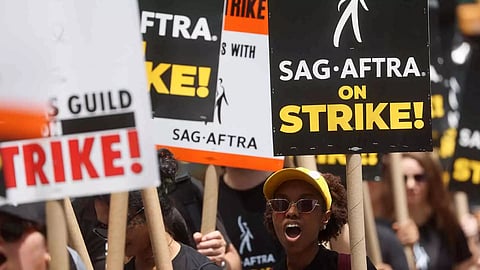

The strike by actors and writers in Hollywood is a significant landmark in the entertainment industry. In the first strike by the acting and writing communities together since 1960, some 1,60,000 artistes have walked off work, bringing productions across multiple media to a stop. While on the face of it, the Screen Actors Guild and the Writers Guild of America are fighting for a better pecuniary deal for themselves—a fairer split of profits from streaming giants and better working conditions—the issues they have raised go much deeper. The strike at this juncture, when AI has opened up enormous possibilities to the entertainment impresario, raises basic questions about art and its ownership: Does art belong forever to the artiste or to its purchaser? Should commercial proceeds accrue to the artist in perpetuity? If not, how should they be shared and distributed?
What has offered momentum to the strike is the participation by high-profile actors including Matt Damon, Emily Blunt, Robert Downey Jr., George Clooney and Cillian Murphy. They have helped to bring global attention to the questions the strike raises. This is an opportunity to carry out a just redefinition of art in the face of a quantum jump in technology. The outcome will influence decisions on art ownership and income distribution in other locales and through the rest of the century.
The Hollywood strike serves as an example to the Indian industry of how front-ranking artistes can raise their voices to secure justice for their comrades and to assert their social conscience. In India, there have been sporadic, isolated instances of film industry guilds going on strike but rarely have matinee stars joined them or assumed the role of spokesmen. They remain in the shadows, either non-committally or cosmetically committed. The Hindi film industry famously went on strike in 1986, with several stars joining, but that was an agitation more oriented to securing producers’ interests rather than the artistes’ per se.
Film stars have done the Samaritan bit whenever the need arose, as Sonu Sood did during the pandemic. Some run charities while others appear for fundraisers for a good cause. But that’s more in the nature of charity rather than for lobbying for the wider interests of their art gild. It’s important for frontline stars to get involved in shaping policy relating to the entertainment industry. It helps build public opinion and wields an outsize influence on the decision-makers. Had the stars led the cause, recording artistes would not have had to go without any royalties for their music for decades.
Such involvement can also help fill existing gaps in the industry. Although it’s more than a hundred years old, the sector remains unorganised and continues to operate without statutory safeguards and welfare features mandatory for organised industries. While all the various crafts that make up the film industry do have their unions, the ambit of their work tends to be limited to securing better amenities for their members rather than their craft as a whole. The industry needs institutionalised policies on sexual harassment, working hours, compensation for extra hours, uniform minimum rates, insurance, health benefits, retirement benefits, unemployment insurance and occupational safety. Frontline film stars must speak up on contemporary industry issues like monopolisation of distribution channels and denial of distribution channels to small-budget films. If the stars speak, they will be heard.